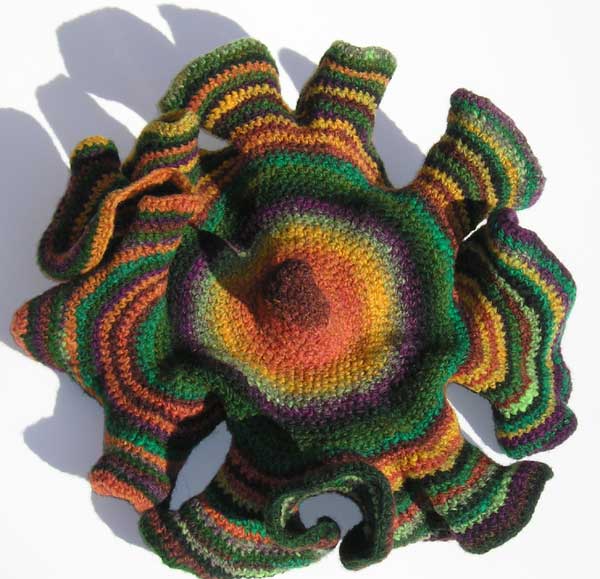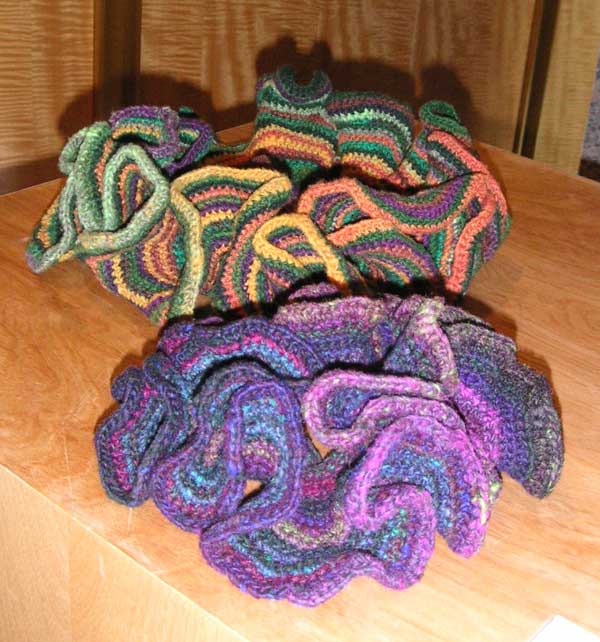

In this exhibit:
 |
Symmetric hyperbolic plane Wool, 10"l x 10"w x 8"h |
 |
Hyperbolic plane - pseudosphere Wool, 14"l x 14"w x 6"h |
 |
Annular hyperbolic planes |
 |
Symmetric hyperbolic plane Because hyperbolic space has infinitely many symmetries, you can sculpt out of them whatever you want. The series in this show demonstrates how different the same shape can look. |
|
Artist's statement |
I was born in Riga, Latvia. All my formal education is in mathematics and theoretical computer science. I got my PhD degree for thesis "Behavior of Different Types of Automata and Turing Machines on Infinite Words" in 1990. My thesis advisor was Professor Rusins Freivalds, now well known name in quantum computing. For 20 years I was teaching in University of Latvia, where most of my students were prospective mathematics teachers. I was also leading numerous workshops for teachers and editing math textbooks in Latvia. But one of my hobbies always was knitting that I learned in middle school. I learned how to crochet on my own because I liked to use crochet to finish my knitting projects. I was seeing patterns and algorithms in knitting and crochet but I was not connecting it with my professional work in mathematics until 1997 when I became a Visiting Associate Professor in Department of Mathematics, Cornell University. Once I was participating in geometry workshop led by Professor David Henderson. He was showing a paper model of hyperbolic plane that was made using William Thurston's idea of annuli. And then it came in my mind - if one can make it out of a paper, then I should be able to crochet it and to get a more durable model to use in my geometry class. In that fall I was assigned to teach Math 451, using Henderson's book "Experiencing Geometry". During summer 1997 I made my first classroom set of hyperbolic planes and used it in my geometry class. It was amazing to see how much it helped my students to understand the nature of hyperbolic plane. Since then I have made numerous models of hyperbolic plane, including crocheting figures for 2nd and 3rd edition of "Experiencing Geometry". For the last one I am now co-author with my husband David Henderson, who always has some idea what I could crochet next to use in his or my classes. In 2003 I started to exchange e-mails with Margaret Wertheim about how to crochet these models (she learned about them from New Scientist), and in May 2004 The Institute for Figuring invited us to give a public lecture "Crocheting the Hyperbolic Plane" (see www.theiff.org for more information). For classroom models I use acrylic yarn because it is more durable and easy to clean. For this exhibit I did some of these shapes in wool to stress that we can find hyperbolic shapes in nature, we are just not used to notice them as easy as we do with flat or spherical shapes that are other common surfaces with constant curvature. We all know positive numbers, negative numbers and zero. For surfaces we can use a notion of curvature - zero curvature is flat surface, sphere has constant positive curvature. It is logical to ask - but what surface has a negative constant curvature and how does it look? The answer is hyperbolic plane and looking at the models you can see how differently it can appear and how amazingly it can be sculpted starting from the same basic shape. |